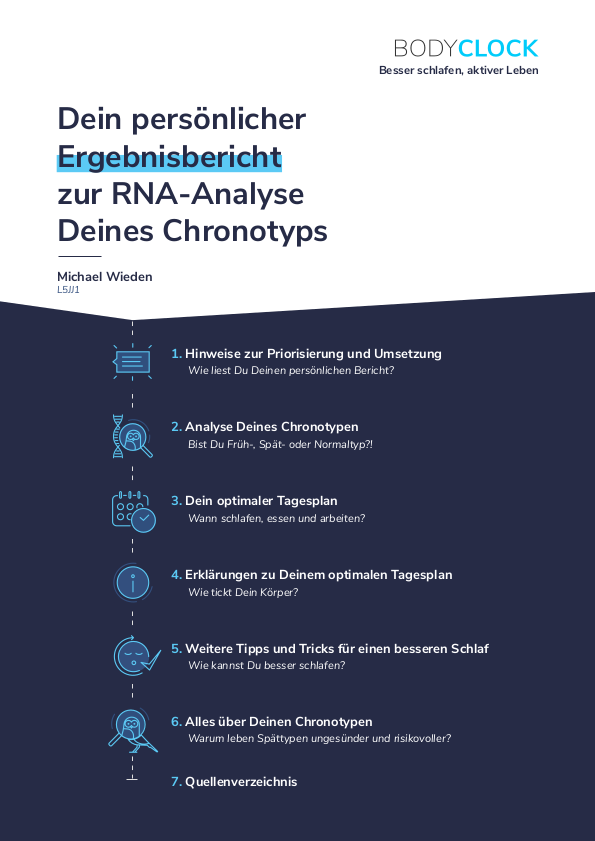
BodyClock Chronotype Results Report by Michael Wieden
Michael Wieden is considered a pioneer in chronobiology in human resource management and has already applied the RNA Chronotype Test in connection with the Chronotype Result Report in several pilot projects in clinics and companies. As a business economist and expert in human resources management, he has been dealing with the question of how chronobiological parameters can be used in human resources management since 2002 . And his interest is no accident. He is an extreme late type and, with its characteristics, belongs to only 1% of the population with the same chronotype. They have a very difficult time in our society, which is primarily geared towards early types.
Michael Wieden has provided us with his own chronotype result report of the BodyClock RNA hair root test for chronotype determination, and will explain it for you below. He will not go into every detail, but will address the most important statements of the results report and supplement them with his own experiences.
You can download the complete BodyClock Chronotype results report by Michael Wieden as a PDF here .
Use is only permitted for private purposes. Any other publication in whole or partly is not permitted.
- BodyClock Chronotype Results Report by Michael Wieden
- I am extremely late type
- The following always applies: Nature knows no time
- DLMO and Chronotype
- Chronotype result report – daily schedule
- Chronotype Result Report – Your recommended Sleep Times
- Chronotype Result Report – Your Recommended Meal Times
- Coffee?
- Alcohol and sleep
- Chronotyp Ergebnisbericht – Deine empfohlene Arbeitszeit
- Chronotyp Ergebnisbericht – Empfehlungen zum Licht
- Chronotyp Ergebnisbericht – Empfehlungen für Deine Sportzeiten
- The late type person
- Chronotype Results Report – Summary
I am extremely late type

This it is, my chronotype. I am extremely late type. I didn’t choose it, it’s in my genes, and yes, I’ll admit right from the start that I’d rather be an early type, because I actually enjoy the mood in the morning when you enjoy an espresso in your favorite street café very early in the summer , the road sweeper drives by and you can watch the rising activity.
Strictly speaking, I also enjoy being able to work in peace and quiet until late at night or even early in the morning. No phone calls, no outside noise, fully concentrated. We don’t have a TV. And I’m lucky because my wife is also one of these 1%. She’s actually 15 minutes later than me. Only she has a higher need for sleep than me. So I’m usually at my desk one hour earlier. But we are grateful for this situation, because it is by no means a matter of course that two such rare chronotypes meet and … like each other ;-).
No, we can’t always live out our chronotypes, but we are mostly in the fortunate position of being able to get up without an alarm clock. This also rarely occurs in society, which I can confirm after 20 years of conversations with a wide variety of people.
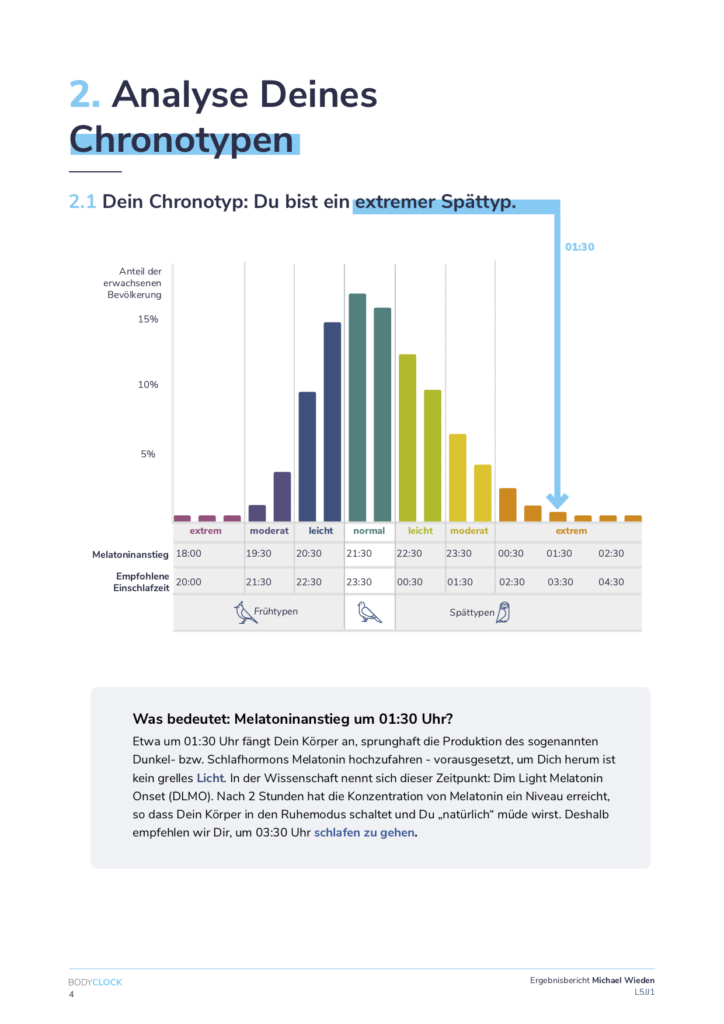
I would now like to take you through my Chronotype results report. Sure, of course, it’s primarily of interest to late-career types, but a lot of core information is relevant to everyone. I will also not explain each side explicitly. We can do this in a ChronoCoaching based on your personal report. So if you want to have all the content tailored to you, you should do the test yourself. Click here to go to the order page.
The following always applies: Nature knows no time
With everything you read about times and periods of time, please always remember that nature does not know seconds, minutes or hours, but only rhythms. Time measurement is a human invention to meet the human need to structure and coordinate processes. Interestingly, only humans need this, no other creature measures time. On the one hand, this has of course made technical progress possible, on the other hand, time measurement has made us dependent on itself and removed us from our internal clock in a damaging way. By the way, there is a clear difference between beat and rhythm. Beat does not allow scope, while rhythm adapts to needs and circumstances (see e.g. heart rate).
Therefore, always consider all times and periods as “approximate information”.
DLMO and Chronotype
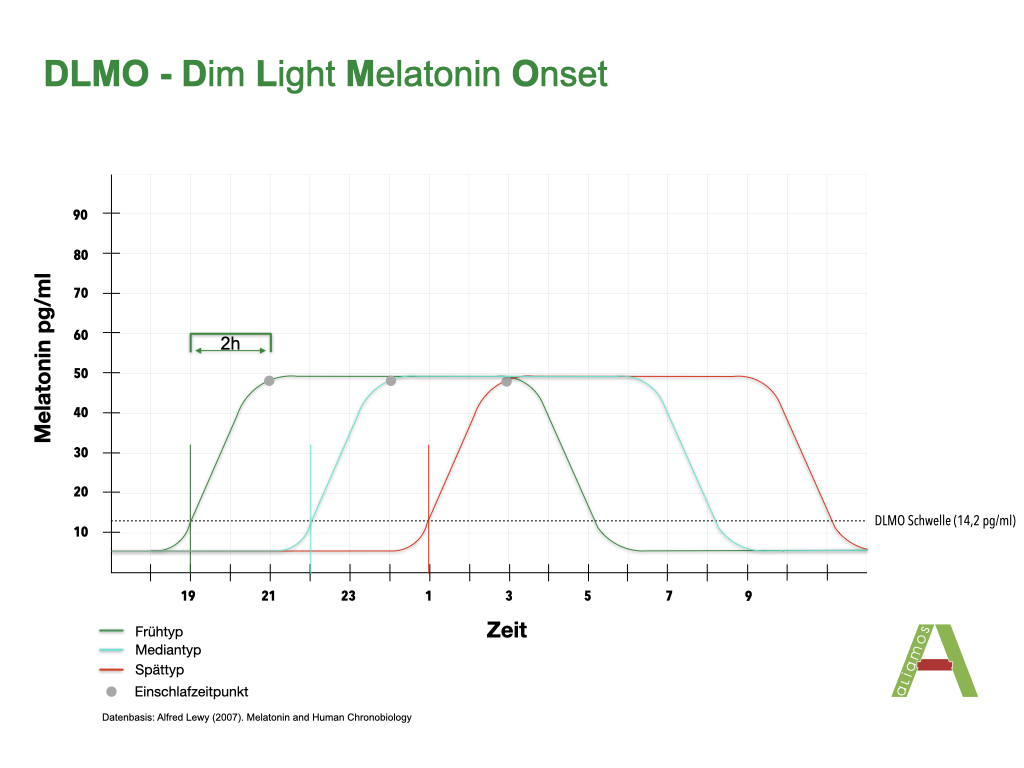
The linchpin of your chronotype and the resulting times is the DLMO or at length
DimLight Melatonin Onset. The DLMO is the point at which your natural melatonin release exceeds a certain threshold (14.2pg/ml) due to genetic factors. From this point on, the biological sleep phase is heralded by growing tiredness.
The DLMO is determined by analyzing the activity of 25 genes at the time your hair root is sampled. It is set as a fixed time, in my case 1:30 a.m. (CET) at night. If you want to know more about the DLMO, you can find more of my articles here.
As a rule, in the BodyClock – Chronotype result reports on it 2.5h of growing tiredness, i.e. constantly rising melatonin level is added, at the end of which the biological time of falling asleep. So we would have arrived at 4:00 a.m. when I fell asleep. Realy late … isn’t it? Since this sleepiness period can be very variable and is definitely shorter in my case, my chronotype result report was calculated as 2h, resulting in a fall asleep time of 3:30.
On average, humans need about 8 hours of sleep. There are people who need less sleep, and people who need more. Don’t confuse need for sleep with duration of sleep. The former is also genetically determined in its basic features and is supplemented by sleep pressure, which arises from exertion and a lack of sleep. Based on all these basics, I have a biological sleep window from 3:30 a.m. to 11:30 a.m.
My everyday life
In our everyday life it doesn’t look quite so dramatic. Most of the time we can fall asleep very easily around 2:00 a.m., although I could actually often still be working at this time. But this enables us to be able to sleep in for the most part in order to be able to optimally meet the professional requirements. So we found a good balance, although of course there are always situations where the alarm clock is unavoidable.
Chronotype result report – daily schedule
This is the second important section of the Chronotyp results report. The times given here are based on the biological sleep time determined above. This daily plan gives you an initial overview of a daily structure that is 100% based on your biological sleep window. Of course, this is usually only possible and sensible under perfect frame conditions.
Basically, the following applies: Any optimization that can only be maintained under stress is not optimization. So see your daily plan first and foremost as an impulse or as a starting point from which you can then gradually determine to what extent it is possible for you to comply with the recommendations. First of all, it is important to be aware of the effects of your chronotype. In the ChronoCoachings on Chronotype result reports, for example, we usually always perform a small ABC analysis.
A = simple and short-term, under certain circumstances only implemented in parts
B = to be implemented in parts if necessary with advance notice and agreement
C = not to be implemented for the time being
This takes the pressure off and focuses on what is feasible and not on what is not possible.
In the following, the chronotype result report of BodyClock will now deal with the individual points more intensively.
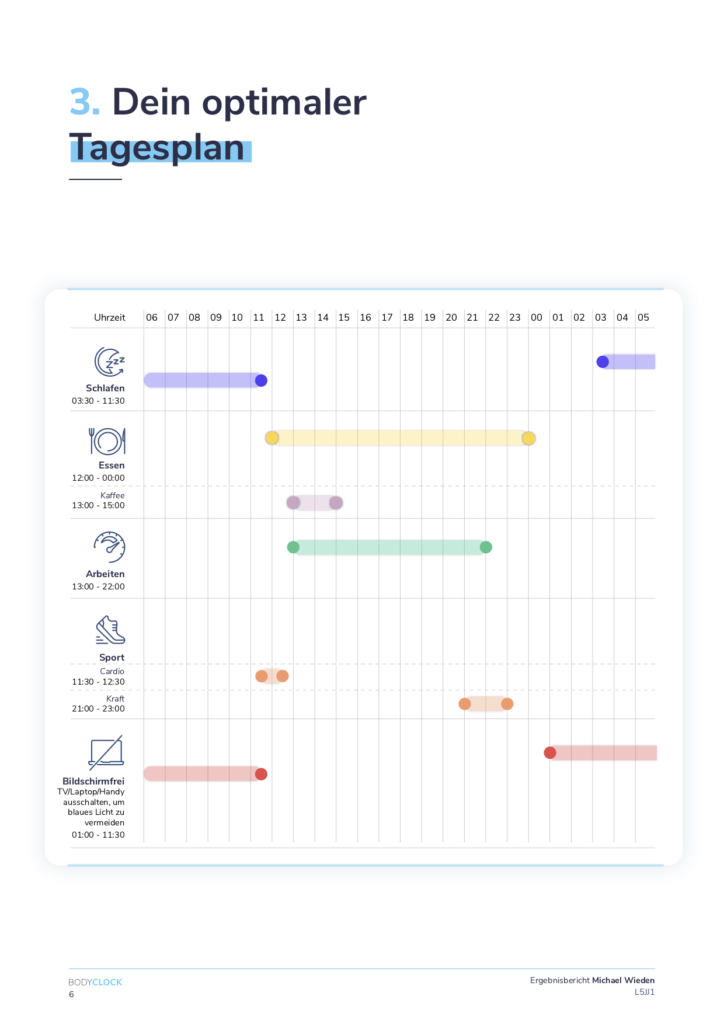
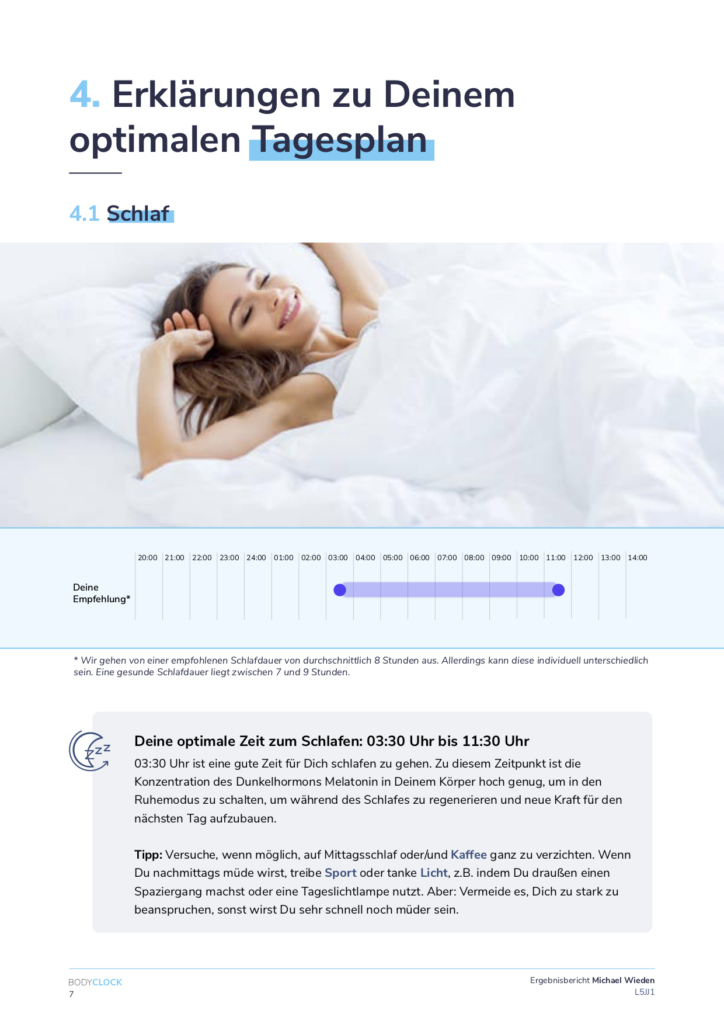
Chronotype Result Report – Your recommended Sleep Times
I have already explained above how the sleeping times are calculated. You can judge for yourself whether the 8h sleep requirement is right for you. 8 hours fit very well for me, but my wife has a biological sleep requirement of 9 hours. This cannot be determined using the RNA test, but can only be experienced in practice. However, this is difficult to do under “alarm clock” conditions.
If you really want to find out your biological need for sleep, then there is only one possibility: fall asleep and waker up for 2 weeks without any external stimulus (alarm clock, partner, noise, etc.). After approx. 10 days you will have left the area of conditioned sleep behavior and will achieve a “free swinging” natural sleep/wake rhythm. On the one hand, this shows the timing of your biological night and, on the other hand, your biological need for sleep.
It is also necessary to consider the effects of medication and illnesses on sleep requirements. An existing or experienced burnout f.e., can have a long-term influence on the need for sleep, just like a viral illness that has gone through. However, this should not to be considered as “natural”, but as a symptom and should also be regarded as such. This is especially true if you don’t feel like you’ve had a good night’s sleep despite sleeping late.
IMPORTANT! One often reads in the media that experts speak of a “recommended length of sleep”. This is often misinterpreted as “sufficient sleep duration”. However, it is meant to mean that one should not sleep less under any circumstances. It’s like the air: if there is sufficient oxygen to live, it doesn’t necessarily mean that there is enough to stay healthy or to perform at a high level. I also always compare it with the german school grade “sufficient”. This also means: It is just enough to survive, but you cannot achieve much with it.
The following always applies: Even if you are woken up with the alarm clock after a recommended sleep time, you will not finish sleeping. As a result, the body cannot fully regenerate. Added up in life, this can lead to negative health consequences.
Oh, and for those who think that their body can get used to little sleep, this article is for you, because there is nothing positive about getting used to it.
Chronotype Result Report – Your Recommended Meal Times
What means breakfast for a latetype person? A late breakfast? My recommended meal times are between 12pm and 12am. So there is no chance of breakfast in the traditional sense of a meal early in the morning. Breakfast is said to be the most important meal of the day. In short, it’s a myth that eating early in the morning is everyone’s most important meal of the day. But it is true that the first meal of the day, at the right time, is absolutely essential. There are two things to note:
- “Early” is relative, because while an early type’s body craves for food early in the morning, a late type’s body is still wired for sleep at the same time. This also applies if the person is violently awakened from sleep by an alarm clock. Many late types who are woken up with an alarm clock report that they are not hungry at all for the first few hours. The rule here is: no hunger, no food! Your body has good reasons to give signals.
- So it makes sense not to talk about breakfast, but about the first meal of the day. It is actually the word “early” that makes the statement that breakfast is the most important meal of the day a false statement.
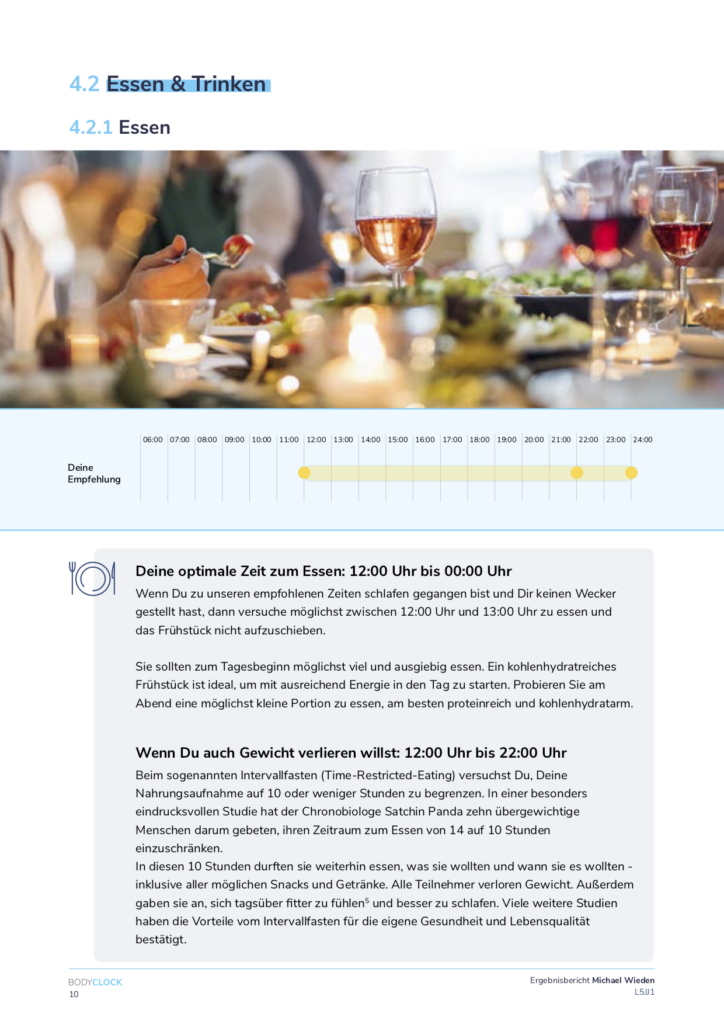

Coffee?
Sleep and coffee are diametrically opposed. On average, people need 5-6 hours until just 50% of the caffeine has been broken down. According to a study((https://www.researchgate.net/publication/222142316_Caffeine_intake_200_mg_in_the_morning_affects_human_sleep_and_EEG_power_spectra_at_night)), test persons still carried 18% caffeine even after 16 hours. This amount can already be enough to cause problems falling asleep. I used to drink 7-8 cups of coffee a day, which meant that I rarely slept more than 5-6 hours. It wasn’t until I started getting anxiety attacks on a regular basis that I drastically reduced my coffee consumption. The result: the anxiety attacks disappeared. Since then, I hardly ever drink caffeinated coffee. The interesting thing: Every time I now drink caffeinated coffee, the anxiety comes back with the second cup.
I’ve had to realize over time that I’m not alone in this. In countless coaching sessions and discussions, customers told me about anxiety disorders and sleep disorders with high coffee consumption. By reducing or doing without coffee, for many (not all) the problem has actually also disappeared.
My advice: Simply do without coffee completely for two weeks and see what happens. If it doesn’t work at all, then only until about 3 hours after getting up. But then you should also be aware that it has developed into an addiction. Any long-term, regular (!) craving for something that the body does not need to survive tends to be viewed as an addiction. In practice, it has often been shown that decaffeinated coffee is an excellent alternative after a changeover phase, even if many people don’t want to believe it. And finally… well rested people no longer need caffeinated coffee anyway.
Alcohol and sleep
“I fall asleep particularly well with alcohol!” I hear this often. Yes, this is definitely the case, but at the same time there is a good chance that wine in particular can cause you to wake up after about 4 hours and not be able to fall asleep again. I can also report this from my own experience.
The blood alcohol after 2 glasses of wine (0.54 per mil) needs 4.5 to 6 hours to break down. Just google “permille calculator” and do the math.
And as with food, to put it simply, a body geared towards sleep is not set up to break down alcohol or process food at the same time. Last but not least, nocturnal breathing pauses can also have their origin in the evening alcohol consumption.
Mein Tipp teile ich mit der Empfehlung im Chronotyp Ergebnisbericht: Verzichte auf Alkohol direkt vor dem Schlafen gehen.
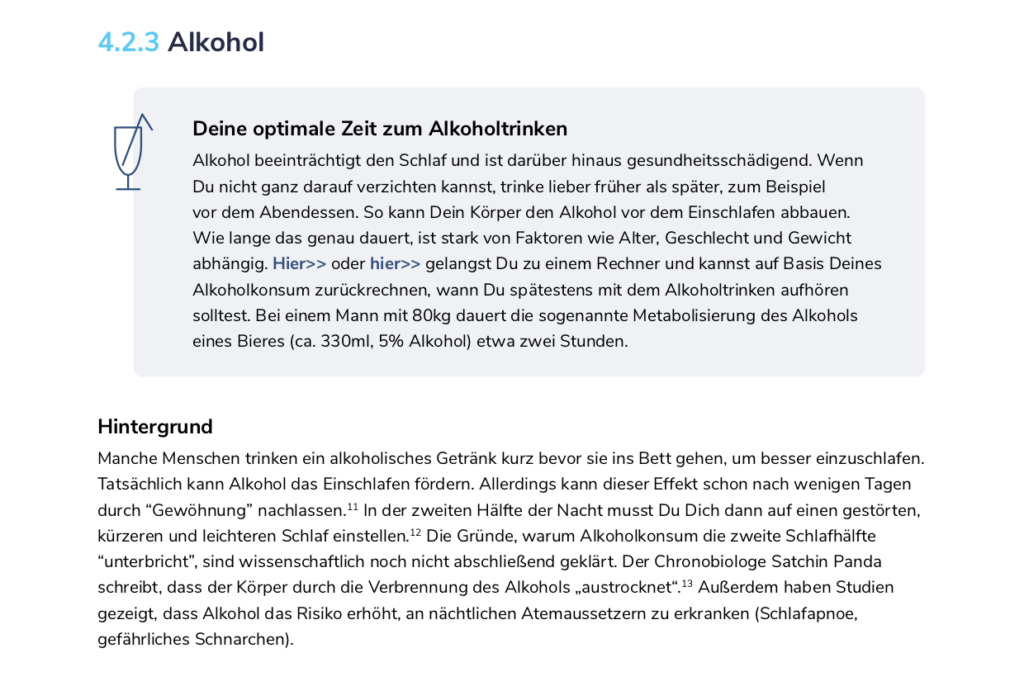
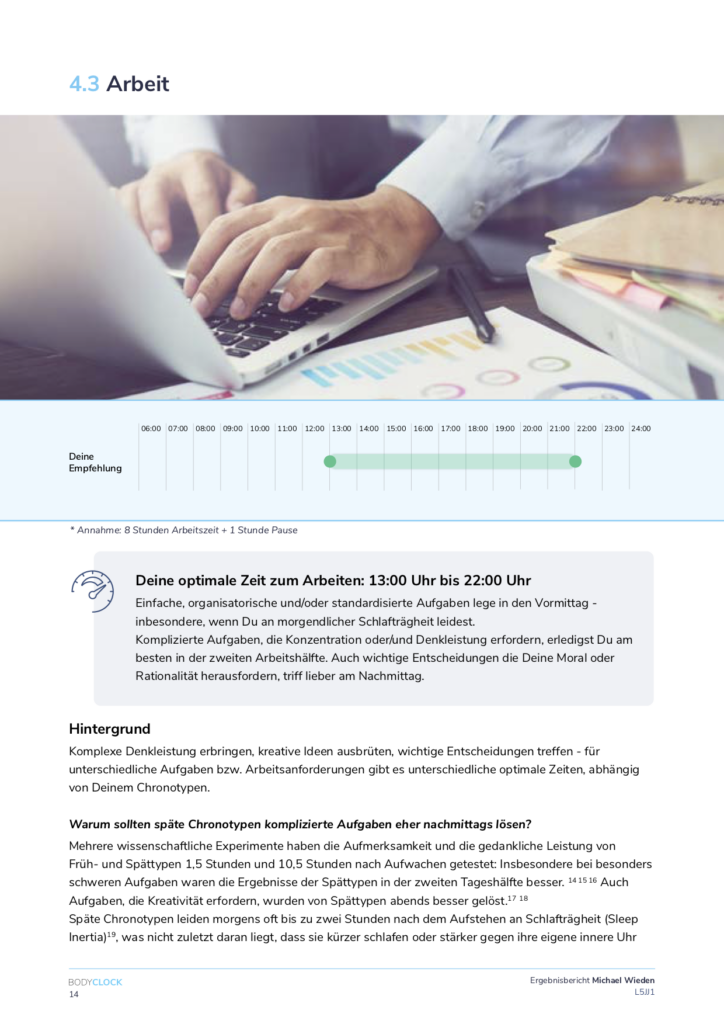
Chronotyp Ergebnisbericht – Deine empfohlene Arbeitszeit
Meine optimale Zeit zum Arbeiten ist laut meines Chronotyp Ergebnisberichts 13:00 Uhr bis 22:00 Uhr. In the chapter “Sleep” I already indicated that we have pushed this recommended sleeping time forward primarily for reasons of social compatibility. In general, this also applies to late types: As long as you can fall asleep earlier, this is not a problem. However, I never recommend taking sleep-inducing medication just to help you fall asleep earlier. In this context, it makes more sense to address the topic of “nutrition” and, above all, to take a closer look at the lighting situation (click here for the paragraph on light). Simple adjustments are often enough to actually be able to fall asleep earlier.
It is important to observe yourself at work, when during the day you can do which work better. In times of low concentration, it makes sense to carry out standardized processes. In times of high concentration, on the other hand, there should be work that requires creativity and mental strength. This is especially important if you can’t sleep late. I myself clearly notice that my best times are between 3:00 p.m. and 6:00 p.m. and later again from 10:00 p.m. How long the “night high” lasts depends on other factors, but at least until 1 a.m.
In this second phase, I noticed that the “desire” to work only comes with doing. It’s not that I enthusiastically throw myself into work at 10 p.m., but rather that I first have to overcome a short “bastard phase” in which I don’t fall for a streaming TV series or a film (we don’t have TV). But then it’s really fun, and it’s not uncommon for me to force myself away from my desk in good time. In addition, the timing is important. If I only sit down at my laptop at 11 p.m., I can no longer get the curve. But if I go back to work by 10 p.m. at the latest, my concentration stays up until late at night.
Stimulus for decision-makers
Employers in particular can also benefit from this when it comes to optimizing processes chronobiologically. In concrete terms, this means that internal company processes are coordinated in such a way, that employees work on certain processes as best as possible at that times, when the best biological conditions for optimal output exist. We have shown how this can work in the “COPEP” project. In this way, error costs can be reduced and at the same time the health of the employees can be protected, above all by reducing the risk of accidents. Sleep deficit costs the German economy almost €60 billion/year. This shows the potential for each individual company in taking the biological sleep situation of employees into account.
Chronotyp Ergebnisbericht – Empfehlungen zum Licht
Sunlight is the factor that affects the body clock the most. Although it has no fundamental influence on your chronotype, it is crucial for synchronizing your inner clock with the daily cycle. For example, it allows your inner clock to be adjusted to the time-delayed daily cycle of a different time zone. This system has been refined over millions of years, moreover in the entire fauna and flora.
Artificial light, on the other hand, has only been around for a few minutes in evolutionary terms. When it was developed, nobody took the effects on the body into account. However, one of many important influences is on melatonin release. Which part of the light spectrum of the sun reaches you when you are outdoors depends primarily on the time of year and day, more precisely on the angle of incidence of the sun. This has the consequence, for example, that the proportion of bright blue light increases in the morning, reaches its peak when the sun is at its zenith, and then decreases again until the proportion in the afternoon is negligible. This blue light component suppresses the release of the sleep hormone melatonin.
In the first half of the day, it is extremely important that you come into contact with sunlight for a certain amount of time. It doesn’t matter if it’s cloudy or not. Alternatively, you can speed up the morning “getting fit” process by using a daylight lamp. Put it in the bathroom or at the breakfast table. 15 minutes are enough to influence the melatonin level and to give your body the signal “Wake up, it’s day!”.
Nightmode
In the evening, on the other hand, bright blue light is poison, because the effect just described ensures that the melatonin level necessary for falling asleep cannot build up. The displays of smartphones, tablets, laptops, etc. act like a daylight lamp. So the body constantly gets the signal “It’s still day!”.
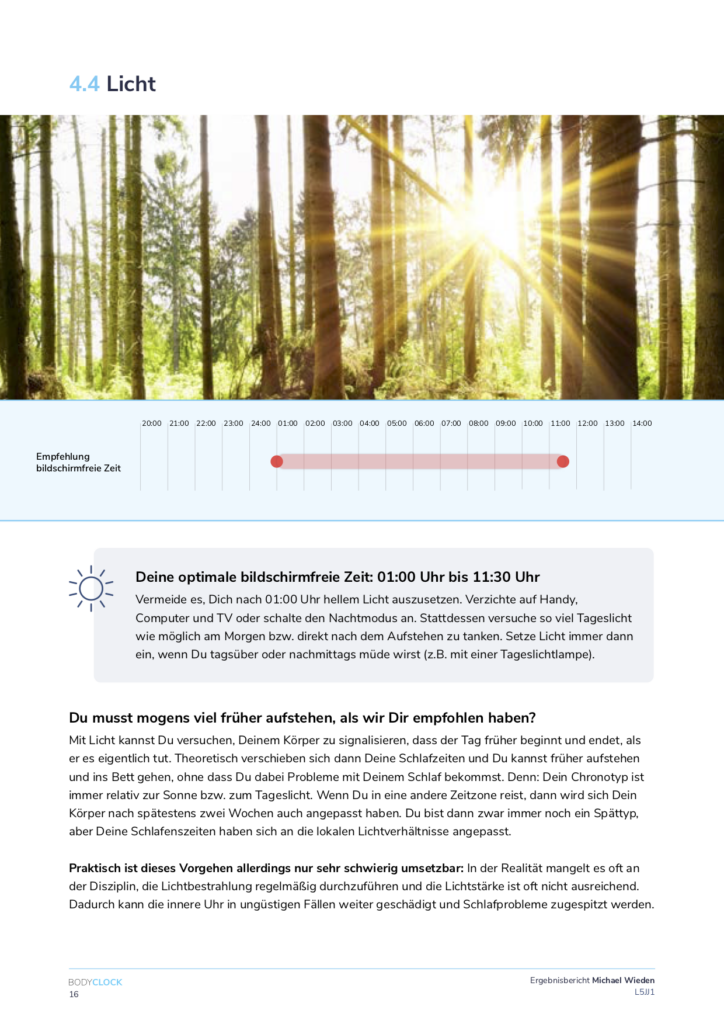
All current operating systems have a so-called “night mode” for the screen. This night mode reduces the blue light within the display lighting and also reduces the brightness. The effect: the display becomes darker and gets a red cast. In most systems you can also influence the degree yourself. Most users won’t have a problem if chats, text messages or other information don’t appear in the sexy colorful light. It becomes more difficult for people who work with color, such as graphic designers. Hier gibt es nur die Lösung, entweder tatsächlich rechtzeitig mit der Arbeit aufzuhören (siehe Empfehlung für kunstlichtfreie Zeit im Chronotyp Ergebnisbericht), oder sich schlichtweg weiter vom Display weg zu setzen. The distance also plays an important role. From an ergonomic point of view, 50 – 60cm is recommended. This is a good value during the day. However, if you work at night, you should rather use a larger display and set it at a distance of 70 – 80cm.
Meine Empfehlung zum Chronotyp Ergebnisbericht von BodyClock
Screen always remains a dilema for night workers. In order not to strain the eyes too much, the ambient brightness should not fall below 500 lux. And that brings us back to the old problem, because this gives the body the signal “It’s still day!” So what can I recommend? Clearly the observance of the artificial light-free time. Our body is not evolutionarily adjusted to digitalization and cannot be deceived. And on the subject of “habituation” I had already recommended an article of mine. Everyone has to decide for themselves how important their health is to them. Of course, it also depends on the dose, but there is no general recommendation for this, because everyone ticks differently.
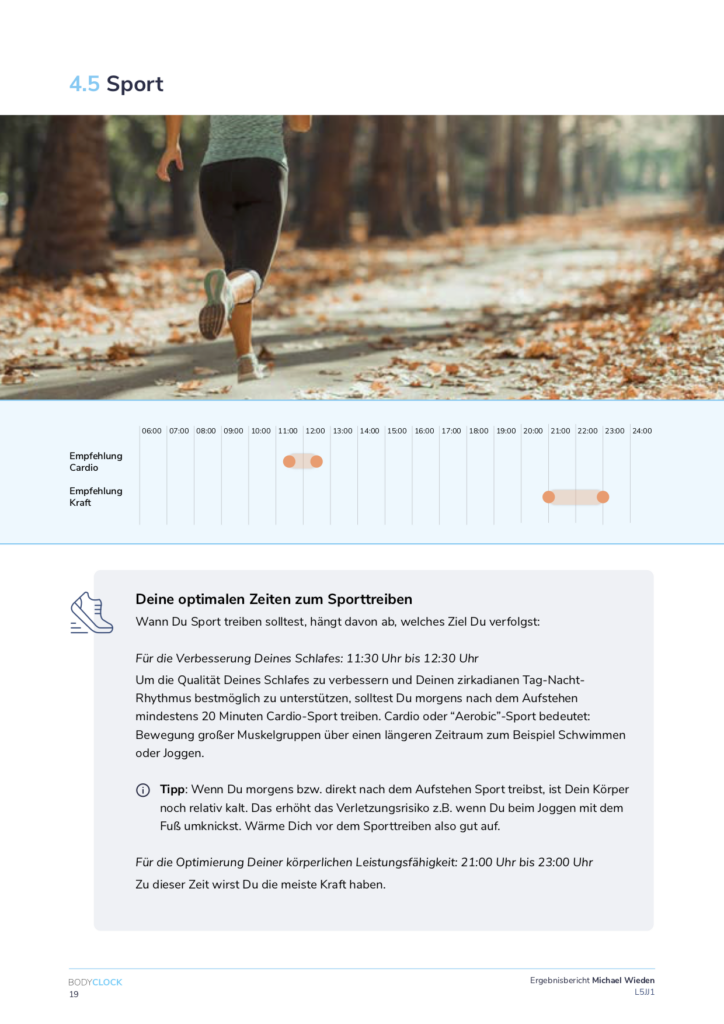
Chronotyp Ergebnisbericht – Empfehlungen für Deine Sportzeiten
For many surely especially interesting are recommendations for sports times in the chronotype result report. You may be surprised to learn that there are not one, but two times that scientists recommend.
Cardio
On the subject of “cardio” I would like to add a personal note. Cardio training includes all endurance sports that increase heart rate, such as swimming and jogging. With the recommendation to do endurance sports immediately after getting up, I want to make a small qualification for my point of view. It is important which goal you pursue. The effect of early cardio training should not be that you are exhausted afterwards and come to work gasping for breath, but that your body gets used to the day and your circulation gets going.
My recommendation for cardio
I recommend that you do your morning cardio training primarily not to increase your endurance but to maintain it. However, if you really want to increase your endurance, do so in smaller increments if you only train in the morning. So never train to the limit in the morning unless you are a competitive athlete and training takes up most of your day or you have enough time to recover before you start work. The Chronotype results report recommendation states at least 20 minutes of exercise, but 20 minutes is relative because the level of exertion should be factored in.
Incidentally, it also makes little sense to get up earlier for training with an alarm clock.
You would therefore start your training in your biological night, which is generally not recommended.
Power
Something I’ve noticed about myself is that I actually do perform better in the latter part of my strength training routine. My problem is that not every suitable fitness studio is open until 11 p.m., especially not on Saturdays and Sundays. Ganz wichtig aber ist der Hinweis im Chronotyp Ergebnisbericht, möglichst nicht nach dem Essen zu trainieren. This is just as true for cardio after getting up as it is for strength training in the second half of the day. The reasons for this are explained very well in the Chronotype results report from BodyClock. However, it should seem logical to anyone that the body can focus on either digestion or performance. It doesn’t work to reel off 100% of both. The order of weight training -> Eat -> sleep is the best basis for restful sleep.
Notice
In the chronotype results report, “morning” and “evening” are also frequently used for late types. Especially for us late types, this can lead to confusion, so the recommendations should be understood more in terms of “first half of the biological day” (instead of morning) or “second half of the biological day” (instead of evening). Because for an extreme late guy like me, “morning” doesn’t really start until “noon”. Similar to “breakfast” rather than “first meal of the day”. From a chronobiological point of view, terms such as early, late, morning and evening are relative and should therefore be chosen with care.
More tips and tricks for the Chronotype results report
Regardless of your chronotype, you will find more tips and tricks in your chronotype results report. I don’t want to list them all now, but I want to add something.
Tip – wake-up light
Basically, the long-term goal is always to sleep in, i.e. to remove the alarm clock completely from the house. But of course there are situations where this will either not be possible at all, or only be possible temporarily. If an alarm clock is unavoidable, then the waking process itself should be the focus of optimization. Did you know that every time your alarm clock goes off, the same alarm processes are going on in your body as when you are being attacked? It powers up from 0 to 100 in a fraction of a second and is primed to fight, flee, or stall. In the first few seconds, it can’t even tell whether the alarm clock is ringing or you’re being attacked by a tiger. Only when the brain begins to grasp the situation does your brain switch to “all clear”. The louder the alarm clock, the stronger the reaction. The softer the alarm, the less violent the reaction.
So I recommend using a wake-up light. Light alarm clocks simulate sunrise. First, they start with a dim light. Gradually, the room is then illuminated more and more. Instead of being suddenly awakened from sleep by a harsh alarm tone, a more natural awakening is possible. Especially in autumn and winter, when it is still dark when the alarm is set, wake-up lights noticeably alleviate the above-mentioned alarm situation, as studies have shown.1.
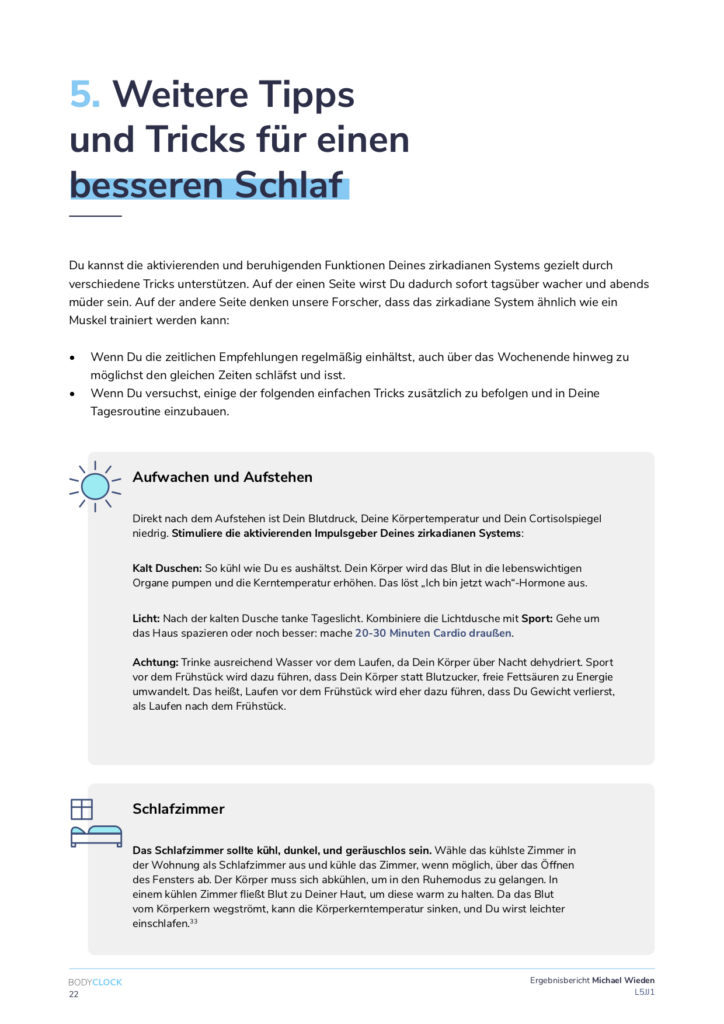
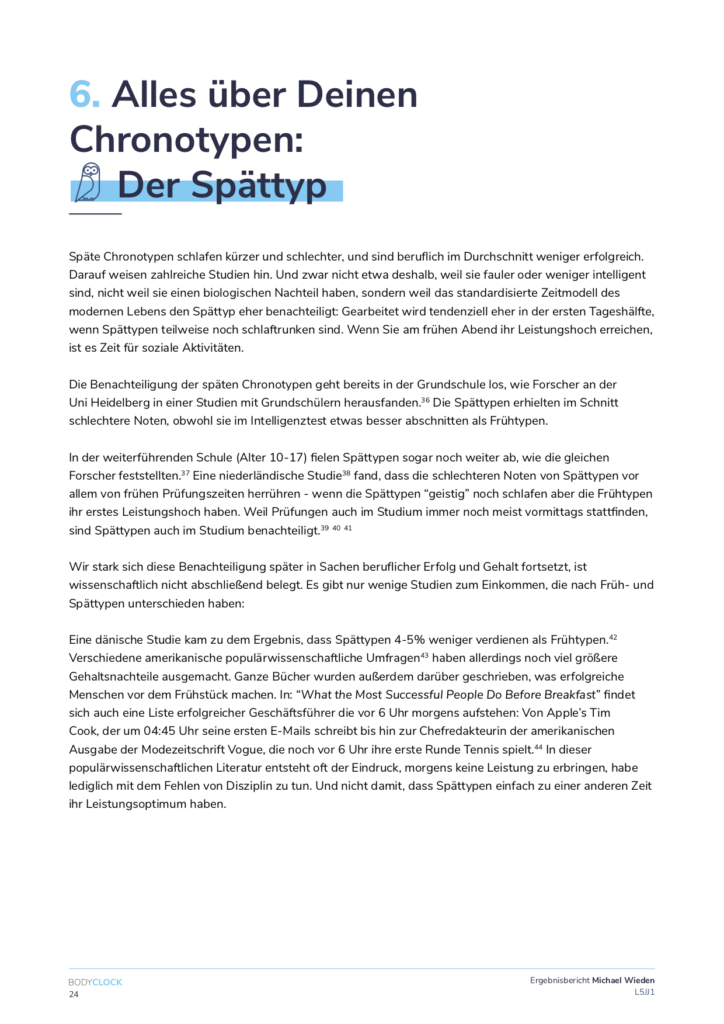
The late type person
Finally, I dedicate myself specifically to all late types. They are the disadvantaged in our society. School times, working hours, study times but also myths are hostile to one’s own genes.
The early bird catches the worm
This is just a saying to show that the early risers own the world. The consequences are clear. School grades, work performance and professional success are denied to late types more often than early types. In the meantime, it has also been proven that this has nothing to do with genes, but rather with the effects of our social structure. Early types, who turn up at work or school at 8:00 a.m. well rested, are more efficient than late types, whose sleep is interrupted every day by the alarm clock, so that they have to go to work overtired. Strictly speaking, our society discriminates((https://diskriminierungsschutz.uni-halle.de/howto/diskriminierung/)) against late types without anyone really noticing.
Opportunities for late types
This fact is one of my driving forces for projects such as COPEP2. A revolution in terms of school start times is also overdue. The preference for the genetic predisposition “early type” is not only ethically questionable, but also squanders enormous economic potential. Numerous studies show that late types, despite better results in the intelligence test, write worse grades due to their schooling3. However, growing digitization in the education sector offers opportunities here. As early as 2012, in my book “Liquid Work, Working 3.0”, I showed ways in which an education system could be structured to prevent this disadvantage for the vast majority of the population.4
Conclusion
Late types are by no means less efficient per se than normal or early types. However, the social structures are constantly pulling on the handbrake, and thus simply ensure that what late types can actually offer is less effective. If you’re a late type, it’s important to understand that possible deficits aren’t your fault, but simply because you can’t, or rather… shouldn’t put your engine’s performance onto the road. ChronoCoachings can be a way of showing how you can better position yourself in the world of early types as a late type, i.e. to bend society around you as much as possible rather than yourself around society. I’m happy to help with that.
Chronotype Results Report – Summary
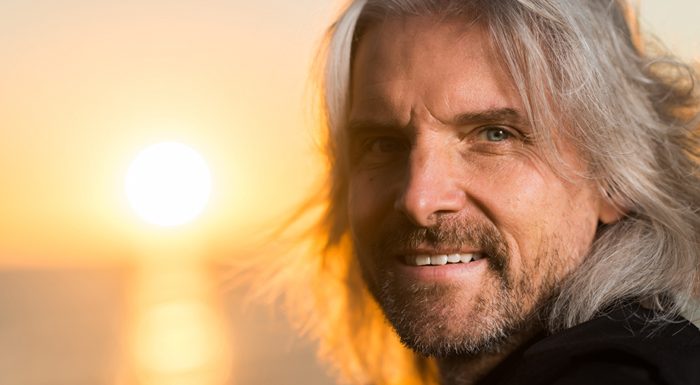
Would you like to discover your own chronotype? The first way to get acquainted with it is of course the BodyClock RNA-chronotype test. You can order it here. Of course, the test result and the chronotype result report that you subsequently receive are tailored to your chronotype, but not to your own personal life situation. In order to provide you with tools and experience on how to implement the recommendations from the Chronotype results report in the context of your individual situation, and thus to bring the power of your Chronotype onto the road, we offer you focused support in ChronoCoachings. The last two 2 years we have been able to help in over 200 personal ChronoCoachings. ChronoCoachings are fundamentally different from sleep coaching, as the focus is not just on sleep, but on the complete 24-hour sleep-wake cycle with all its facets.
You have further questions about the Chronotyp result report? Feel free to contact me personally at michael@wieden.com. You can find out more about me at www.wieden.com.
- https://research.rug.nl/en/publications/effects-of-artificial-dawn-on-subjective-ratings-of-sleep-inertia [↩]
- chronotype-optimized personnel deployment planning [↩]
- https: //www.researchgate.net /publication/268228740_The_influence_of_chronotype_and_intelligence_ on_academic_achievement_in_primary_school_is_mediated_by_conscientiousness_midpoint_of_sleep_ and_motivation [↩]
- Wieden Michael. Liquid Work, Arbeiten 3.0. Wiesbaden: Springler Gabler 2012, Seite 171 ff. [↩]